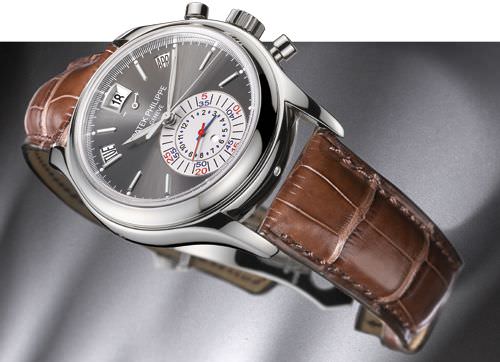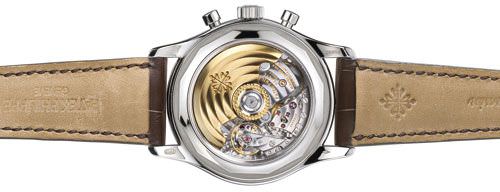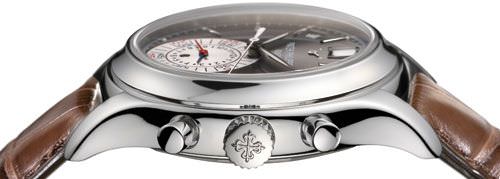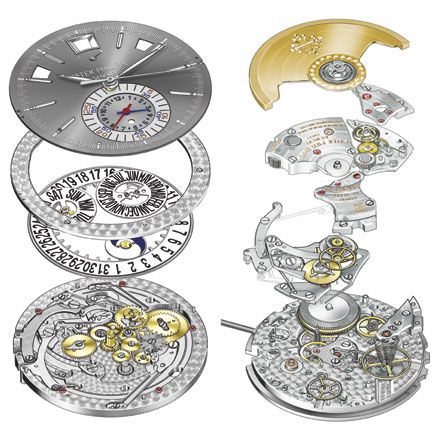
It is well known that Patek Philippe has produced exceptional chronographs for decades, timepieces that regularly reach record prices at auctions. It is also this same Patek Philippe, which, in 1902, applied for the first patent for a flyback chronograph (because of its two chronograph hands, it permits the wearer to measure or maintain the intermediate time, then to make up the lost time). Master watchmakers place this complication at the pinnacle of their art.
Up to now, most of the company’s manual winding chronographs, so prized and sought after, were created on the basis of ébauches produced exclusively for Patek Philippe. These chronograph movements, enriched over time with a perpetual calendar, then a flyback mechanism, are distinguished as much by their technical sophistication (among others, the Gyromax balance, Breguet overcoil, column-wheel) as by their aesthetic refinement (including traditional hand-bevelled bridges, column wheel with chamfered cap), earning them the honour of the Geneva Seal.
In April of 2005, the Geneva manufacturer even presented a very remarkable timekeeper, entirely designed, developed, and produced in its “Haute Horlogerie” ateliers. It is the flattest (5.25 mm) manual winding chronograph movement ever realized, featuring a flyback function and column wheel, inspired by a historic movement from 1903. This highly prestigious piece is crafted in the traditional manner, and in a limited edition.
Still, there was something missing from the line-up of chronographs, something that Patek Philippe’s enthusiastic fans have long been waiting for: an automatic chronograph, exclusively crafted in-house by the Geneva brand.


A philosophy that considers the user
Let’s go back, if you will, to ten years ago. Patek Philippe’s 1996 launch of its patented Annual Calendar opened a new road, combining technical complication with simplicity of usage. Thus, in a way, began the “useful” complication…
It is precisely this innovative philosophy that is behind the new Automatic Annual Calendar Chronograph (reference: 5960P) being presented by Patek Philippe today. It is simple to use, functional, easy to read, has a straightforward display, and a purity of style mixed with modernism…
The launch of this new automatic chronograph does not, however, call into question Patek Philippe’s other traditional chronographs, which will continue to be developed in parallel. These two processes require a different approach to watchmaking. While one is spectacularly traditional in its construction, which can be admired through the transparent sapphire crystal case back, the new one is perfectly functional. Let’s take a closer look.
A (red) touch of sportiness
Stylistically, the new automatic chronograph is designed with an elegance in keeping with Patek Philippe’s timekeeping classicism. Yet, it has a touch of modernism that evokes sportiness. One of the essential characteristics is the display of the chronometric functions on a “mono-counter” located at 6 o’clock. On the outer circle is the 30-minute counter, with its red numbers and red hand; on the inner circle is the 12-hour counter in black; at the centre is the day/night indicator given by a small disk that progressively and poetically moves from white to dark blue (an essential indication for adjusting the calendar).
An additional particularity of this timepiece is that the minute counter is said to be “continuous” as opposed to the counters that are considered “semi-instantaneous.” This means that its hand advances in a constant manner, without a jump at each minute. Beyond this technical aspect, the “mono-counter” offers perfect and immediate readability that is undoubtedly greater than that offered by separate counters. It also gives this new automatic chronograph a strong personality with a resolute character.
Between 10 and 2 o’clock, three large apertures display the day, large date, and the month of the Annual Calendar. As its name indicates, it requires only one correction per year, at the end of February. For the rest of the year, the watch automatically recognizes whether a month has 30 or 31 days. This yearly correction is made on March 1, using either the crown or a date corrector placed between 9 o’clock and 10 o’clock on the side of the case, where the three correctors for the day, date, and month, in that logical order, are found.
Just under the large date aperture (there is one single opening for both numbers, another interesting feature since large dates are often placed in two different apertures), we find a discreet indicator for power reserve (55 hours). It is placed so that it does not hinder the extreme readability of the main functions of the chronograph.
All these indications are clearly visible on a two-tone anthracite and silvered dial with its white gold “shell” style hour markers, and its hour, minute, and sweep seconds hands. The latter also serves as the seconds hand for the chronograph. At 2 o’clock and 4 o’clock, two traditional style pushbuttons reinforce the “contemporary retro” design of this sturdy timepiece, whose diameter is 40.50 mm. The first pushbutton activates the start and stop of the chronograph, while the second sends it back to zero, i.e. the flyback function. With a single push on the corrector button, it allows the hand to be instantly restarted from the zero position.
The long and complex road to simplicity
As with all art, to achieve simplicity, and in this case, simplicity in usage, efficiency, and reliability, is a complex process. Five years of research and development were needed to produce this automatic chronograph, involving some ten specialists and several departments at Patek Philippe.
Its movement is made up of 456 component parts, all assembled on a base measuring 5.2 mm in thickness and 28 mm in diameter, on which is placed the mechanism of the Annual Calendar (a reconstructed Annual Calendar, since the corrector buttons were moved to the other side, leaving space for the chronograph’s pushbuttons), for a total diameter of 33 mm.
The particular technical construction of this movement lets the wearer use the central sweep seconds hand as he sees fit, either as an indication of the time, of the seconds, or as a seconds counter for the chronograph. For the latter, it is “in flight” without having to go back to zero.
Contrary to Patek Philippe’s classic chronographs, the central gearwheel of the seconds rotates all the time. Placed on its axis, a coupling disk connects it to an upper pinion that, when turning, moves the gearwheels of the chronograph’s counters. When the wearer stops the chronograph hand, two clamps raise the coupling disk that immediately releases the gearwheel for the seconds hand, which continues rotating without interruption. It is worth pointing out that the use of the chronograph seconds hand as a sweep seconds hand does not involve any decrease in the power reserve nor any additional wear and tear on the parts.

The sum of current knowledge
The efforts of Patek Philippe’s watchmakers have all been directed towards optimizing the efficiency and reliability of the chronograph: column wheel that, besides its traditional “added” value, commands the start/stop function; gear teeth designed to offer constant energy transmission; balance equipped with a Breguet overcoil… This does not even include the high level of manual finishing, which earns this timekeeper the prestigious Geneva Seal.
The sum of the brand’s current knowledge can be found in this new and exceptional product. It will no doubt contribute to the desire for Patek Philippe by an enthusiast audience enchanted by this inspired, contemporary, and long awaited timepiece.
A fundamental innovation: the “Spiromax®” balance spring

One year ago, Patek Philippe, under its ‘Patek Philippe Advanced Research’ label, presented an innovative escape wheel made of silicon, created using a process called ‘selective photolithography’. This deep engraving process, already employed in the medical and aeronautics industries, is more technically known as ‘Deep Reactive Ion Etching’ (DRIE). The important advantage of this process is that each piece is identical to the next – a sort of collective cloning, if you will – rather than having to individually tool each individual wheel. The result is very high micrometric precision with perfectly smooth vertical surfaces.
The Geneva brand is now using the same basic process to create its new “Spiromax®“ balance spring. The development of this new technology has been conducted in collaboration with several other major players in the Swiss watch sector (the Swatch Group and Rolex, among others), as well as in partnership with the Swiss Association for Horological Research (Association Suisse pour la Recherche horlogère, ASRH), the Swiss Federal Institute of Technology in Lausanne (Ecole Polytechnique Fédérale), as well as with various universities and research laboratories in the Jura region.
But, while the basic research is a collaborative ef-fort, the particular geometry of the “Spiromax®” has been duly patented, and belongs exclusively to Patek Philippe. What are the basic issues and the major advantages of this innovation?
Improving isochronism
The fundamental reason for using the “Spiro-max®” is to improve the isochronism of the watch. By ‘isochronism’, we mean the regularity of the vibrations of the regulating organ, which affects the watch’s operation.
In the case of the classic balance spring, the isochronism can be disrupted by different factors, most notably the asymmetry in the contraction and expansion phases of the balance spring, the variations in its elasticity as a function of temperature changes, the influences of magnetic fields, centrifugal forces and gravity, as well as thermal and mechanical changes at the two points where the balance spring is attached.
Over the course of timekeeping history, several crucial advances have contributed to the improvement of this isochronism, particularly the Phillips curve added to the Breguet balance spring and the invention of Invar, an alloy that compensates for temperature fluctuations.
The fundamental innovation by Patek Philippe resides in the particular geometry of this silicon balance spring. Besides the fact that “Spiro-max®” springs are consistent in quality and performance, their geometry provides for perfect isochronous vibrations, regardless of the ambient temperature, or the position of the movement, or any possible interference from magnetic fields.
Without entering into the complex details of this particular geometry, we can, however, mention several points. Unlike conventional balance springs, the “Spiromax®” spring cannot be terminated with a Phillips curve. Rather, a special terminal curve was created that is thicker at the outer end (impossible to obtain in a conventional alloy), which forces a concentric expansion and contraction of the spring.
A secondary but nonetheless important advantage of this particular geometry is that, without the Phillips curve, the “Spiromax®” spring is three times thinner than the conventional balance spring (0.12mm versus 0.40mm). This in itself opens a ‘royal’ road for constructing a new generation of extra-thin movements.
Among its other advantages is that the attachments of the “Spiromax®”, both for the balance staff and the balance spring stud, are integrated into the device, and not attached by soldering, setting or any other process. This integration ensures that Patek Phillip’s “Spiromax®” is optimally positioned at both ends.
Comparisons of balance springs
If we compare the various balance springs being used today, we observe that, unlike conventional springs, the “Spiromax®” is not magnetic because of its silicon-based material, and that the geometry of its integrated attachments determines the active length of the spring. The resulting intrinsic isochronism does not require fine-tuning, which is a great enhancement given the delicacy of this normal operation. The “Spiromax®” is also more resistant to shocks, while conventional balance springs are subject to deformation if they receive a shock exceeding 1000 G. The weight of the new spring is also less than normal springs (2.37g/cm3 as compared to 8g/cm3), and its particular flat construction makes it significantly less thick than the traditional balance springs.
The “Spiromax®” is a significant demonstration that the most traditional and classic domains of watchmaking have a vested interest in maintaining continuous research in order to obtain the greatest precision and reliability possible. After all, these are the two major objectives of the science and art of timekeeping.
Source: Europa Star April-May 2006 Magazine Issue





